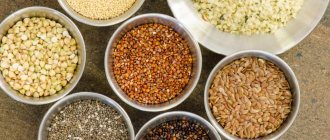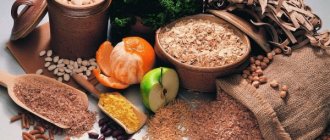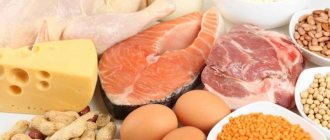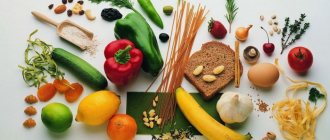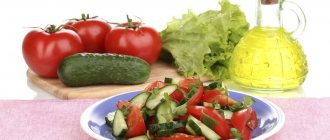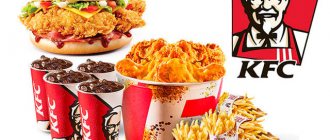Nutrition is an important part of lifestyle. Dietetics has long ceased to be just a part of medicine and has migrated from the pages of scientific articles to glossy magazines about health and nutrition. However, in order to truly eat properly, it is necessary to check all new dietary trends for scientific evidence. A long-known indicator in the scientific community is the glycemic index of foods, and only recently has it acquired significance in the field of “fashionable” dietetics.
For people with diabetes, it is necessary to take into account the glycemic index of foods (GI), since taking into account the index will help control the concentration of sugar in the blood.
The index depends on the method of heat treatment and the content of proteins and fats in the product, as well as the type of carbohydrates and the amount of fiber.
Important facts:
- Initially, the study of this indicator was started to correct the diet in patients with diabetes. But later it turned out that foods with a high GI can raise blood sugar in completely healthy people.
- The more such products enter the body, the more problems it can cause.
- Sometimes even those foods that are considered low-calorie have a high GI and therefore are easy to gain weight from.
- Please note that those foods that contain fiber have a lower GI and are digested more slowly, gradually releasing energy.
- Products devoid of fiber with a high GI provide a lot of energy, but if you do not spend it by leading a sedentary lifestyle, then this energy will be converted into fat.
- Frequent consumption of foods with GI leads to metabolic disorders. Constantly elevated sugar levels increase the feeling of hunger.
Video: everything you need to know about the glycemic index of foods
What does GI depend on?
First of all, the GI level of a particular product depends on the amount of monosaccharides in the composition. However, the glycemic index of foods is a relative concept that can be influenced by multiple factors, such as:
- Cooking – Cooked fruits and vegetables have a higher GI than raw ones.
- Degree of grinding - the more the structure of fiber in food is disrupted, the higher the GI level. Thus, the index of potatoes in the form of mashed potatoes and those cooked in their jackets differs by several tens of units.
- Availability of fiber. The more fiber in food, the slower the digestion of carbohydrates occurs, without causing sudden spikes in blood sugar.
- Freezing. After freezing, the structure of starch changes, resulting in a decrease in GI (fruits, vegetables, rice cooked with vegetable oil).
- Different varieties of the same fruits and vegetables may differ in GI parameters.
- The GI in each specific case is affected by the presence of proteins consumed simultaneously with carbohydrates, which somewhat reduces the rate of absorption of sugars. This point does not apply to people with a pathological increase in insulin (hyperinsulinization).
Glycemic index of foods: table for weight loss
The table is compiled of the most commonly consumed products.
For ease of use, products with the same GI are grouped together. The glycemic index of products indicated in the table is average and approximate. This is due to storage conditions, cooking method, and the initial carbohydrate content of a particular product. Possible changes to the GI will be discussed in the next article.
Download the full table of GI products for the refrigerator for free, PDF 570 kb
| Foods with a high glycemic index of 70 or higher | GI |
| Beer | 110 |
| Dates, hamburger | 103 |
| Glucose, starch, white bread, rutabaga, bagels, fried croutons | 100 |
| Butter rolls, baked, fried potatoes, potato casserole, parsnips | 95 |
| Rice noodles, white rice, canned peaches, apricots, honey, pies, hot dog | 90 |
| Corn flakes, steamed or boiled carrots, popcorn, rice milk pudding, celery root | 85 |
| Mashed potatoes, raisin muesli, crackers, donuts, caramel, candy, condensed milk | 80 |
| Pumpkin, watermelon, French baguette, lasagna, rice porridge with milk, unsweetened waffles, squash caviar | 75 |
| Millet, chocolate bars (Mars type), milk chocolate, croissant, sweet soda, barley, white and brown sugar, chips, semolina, couscous, soft wheat pasta, halva, cheesecakes, packaged juices, jam | 70 |
| Products with an average glycemic index of 50-69 | GI |
| Wheat flour | 69 |
| Pineapple instant oatmeal | 66 |
| Black yeast bread, wheat flour, orange juice, jam, boiled or stewed beets, marmalade, muesli with sugar, jacket potatoes, canned fruits and vegetables, sweet potatoes, rye and whole grain bread, macaroni and cheese, raisins, marshmallows, marshmallows, fruit waffles | 65 |
| Pancakes, pizza, bananas, ice cream, lasagna, melon, mayonnaise, sour cream, oatmeal, cocoa, long grain rice, coffee and black tea with sugar, dumplings, dumplings, pancakes | 60 |
| Canned corn, grape juice, ketchup, mustard, spaghetti, sushi, shortbread, margarine, processed cheese, feta | 55 |
| Cranberry, apple and pineapple juice without sugar, mango, persimmon, kiwi, brown rice, orange, sweet yogurt, cutlets, pork schnitzel, fish cutlets, omelet, fried beef liver, natural coffee without sugar, egg, yolk | 50 |
| Products with a low glycemic index of 49 and below (recommended for weight loss) | GI |
| Dry wines and champagne | 44 |
| Cranberries, grapefruit juice, canned green peas, basmati rice, coconut, whole grain bread, orange juice, buckwheat, wheat pasta, carrot juice, dried apricots, prunes, eggplant caviar, beef, crab sticks | 40 |
| Wild rice, chickpeas, apples, fresh green peas, Chinese noodles, vermicelli, sesame seeds, plums, quince, sesame seeds, natural yogurt 0%, fructose ice cream, soy sauce, boiled sausage | 35 |
| Beans, nectarine, pomegranate, peach, sugar-free compote, tomato juice | 34 |
| Soy milk, apricot, lentils, grapefruit, green beans, garlic, beets, pear, tomato, low-fat cottage cheese, pear, jam without sugar, lingonberries, blueberries, blueberries, dark chocolate, milk, passion fruit, tangerine, green bananas, chicken | 30 |
| Cherries, raspberries, red currants, strawberries, wild strawberries, pumpkin seeds, gooseberries, soy flour, full-fat kefir, split yellow peas | 25 |
| Artichoke, eggplant, soy yogurt, lemon, seaweed | 20 |
| Almonds, broccoli, cabbage, celery, cashews, cauliflower, cabbage and Brussels sprouts (in any form), chili pepper, cucumber, nuts, asparagus, ginger, mushrooms, zucchini, onions, leeks, olives, peanuts, tofu cheese , soybeans, spinach, pickled and pickled cucumbers, bran, kefir, black currants, olives and black olives | 15 |
| Avocado, green pepper | 10 |
| lettuce, sunflower seeds | 9 |
| dill, parsley, vanillin, cinnamon, oregano, shrimp, hard cheese | 5 |
When to consume high GI foods
- during serious physical exertion;
- after long sports training;
- with a sharp decrease in blood sugar (for example, in insulin-dependent patients)
When to Eat Low GI Foods
- if you want to lose weight;
- when leading a sedentary and sedentary lifestyle ;
- during forced reductions in activity, for example, due to illness;
- if desired, restore metabolic processes;
- in case of diabetes mellitus group 2.
Conclusion:
For the vast majority of people, consuming low GI foods is much preferable for the following reasons:
- food is digested slowly, sugar levels rise and fall gradually, not abruptly;
- patients with diabetes can control the increase in blood glucose levels, preventing the progression of the disease and the development of concomitant diseases;
- By using foods with a low glycemic index in your diet, you can steadily lose weight;
- Products with a high glycemic index are only useful for athletes and physically demanding people.
Approximate GI indicators in different product categories
Unfortunately, it is almost impossible to find data on GI in products produced in our country. But in developed countries, this important parameter is mentioned on almost all food products.
To have a rough idea of the size of the GI, we present some data.
High GI foods:
- Chocolates, milk chocolate, fast food, chocolate ice cream, cakes, pastries - GI = 85-70;
Average GI:
- Fruit juices without sugar, pizza, coffee and tea with sugar – 46-48
Low GI:
- Dark chocolate 70% -22, tomato juice -15, meat and fish dishes -10.
Foods with an average glycemic index of 50 to 69
| Product | (GI) |
| Wheat flour | 69 |
| Fresh pineapple | 66 |
| Instant oatmeal | 66 |
| Orange juice | 65 |
| Jam | 65 |
| Beets (boiled or stewed) | 65 |
| Black yeast bread | 65 |
| Marmalade | 65 |
| Marshmallow | 65 |
| Muesli with sugar | 65 |
| Canned pineapple | 65 |
| Raisin | 65 |
| Maple syrup | 65 |
| Rye bread | 65 |
| Boiled potatoes in their jackets | 65 |
| Sorbet | 65 |
| Yam (sweet potato) | 65 |
| Whole wheat bread | 65 |
| Canned vegetables | 64 |
| Pasta with cheese | 64 |
| Sprouted wheat grains | 63 |
| Wheat flour pancakes | 62 |
| Pizza on thin wheat dough with tomatoes and cheese | 61 |
| Banana | 60 |
| Chestnut | 60 |
| Ice cream (with added sugar) | 60 |
| Long grain rice | 60 |
| Lasagna | 60 |
| Industrial mayonnaise | 60 |
| Melon | 60 |
| Oatmeal | 60 |
| Cocoa powder (with added sugar) | 60 |
| Dried fruits compote | 60 |
| Fresh papaya | 59 |
| Arabic pita | 57 |
| Sour cream 20% fat | 56 |
| Sweet canned corn | 56 |
| Grape juice (no sugar) | 55 |
| Ketchup | 55 |
| Mustard | 55 |
| Spaghetti | 55 |
| Sushi | 55 |
| Bulgur | 55 |
| Canned Peaches | 55 |
| Shortbread | 55 |
| Butter | 51 |
| Jerusalem artichoke | 50 |
| Basmati rice | 50 |
| Fish cutlets | 50 |
| Fried beef liver | 50 |
| Cranberry juice (no sugar) | 50 |
| Kiwi | 50 |
| Pineapple juice without sugar | 50 |
| Lychee | 50 |
| Mango | 50 |
| Persimmon | 50 |
| Brown brown rice | 50 |
| Apple juice (no sugar) | 50 |
Advantages and Disadvantages of Low and High Glycemic Index Foods
| GI | Advantages | Flaws |
| High |
|
|
| Short |
|
|
Additional Carbohydrate Options
Carbohydrates consumed with food affect not only the amount of sugar in the blood, but also other processes occurring in the body. In addition to GI, carbohydrates can be classified according to other parameters:
Glycemic load
(GL) of products - a parameter taking into account the amount of carbohydrates in a product relative to GI. You can calculate your GL yourself using the formula: glycemic index * calorie content (per 100 g)/100. The lower the resulting parameter, the better:
- minimum level – less than 10 units;
- medium – from 10 to 20 units;
- high – more than 20 units.
Insulin index
(II) is an indicator of insulin production in response to the breakdown of food after consuming carbohydrates, proteins and fats. At the same time, the GI and AI indicators of carbohydrates can differ significantly. It is necessary to be guided by both tables in order to build an optimal diet for diabetes and for weight loss.
Saturation index
(IN) – the ratio of caloric content and satiety after eating foods. So, 100 kcal of proteins, fats and carbohydrates saturate the body in different ways. The satiety signal occurs when a person eats approximately 250 grams of food, while the total calorie content should not exceed 500 kilocalories at one time.
Metabolic disorders from high GI foods
Energy obtained from carbohydrates is consumed in three ways:
- to replenish expended energy;
- for glycogen reserves in muscles;
- for backup needs in case of energy shortage.
- Storage reservoirs are fat cells located throughout the body. By consuming foods with a high glycemic index, the body is filled with glucose, which is quickly converted into fat . If at the moment the energy is not in demand, the person is sitting or lying down, then this fat is sent for storage in the depot.
Are foods with high GI harmful?
- With constant consumption of foods with a high GI, the level of glucose in the blood constantly remains at an elevated level. Eating something sweet or high-calorie every half hour or hour, even if only a glass of tea with sugar, candy, cookies, buns or sweet fruit, your sugar level will accumulate and rise.
- The body responds to this by reducing insulin production. A metabolic disorder occurs, which is expressed in the accumulation of extra pounds. The fact is that with a lack of insulin, glucose cannot enter the muscle fibers, even if the body needs it at the moment.
- Reserves of unspent energy are sent for storage , deposited in the form of folds on the stomach, sides and thighs.
- With this seemingly constant overeating, a person feels constant hunger and weakness, trying to get energy, he eats more and more. The stomach becomes overstretched, but saturation does not come.
Conclusion:
It is not the high GI foods themselves that are harmful, but their excessive and uncontrolled consumption. If you have worked hard, or spent a couple of hours in the gym, then a high GI will help restore energy and give you a surge of vigor. If you eat these foods in front of the TV at night, then fat deposits will grow by leaps and bounds.
Are Low Glycemic Index Foods Really Healthy?
Products with slow carbohydrates are good because they gradually maintain energy at the desired level. By using them, you will not get bursts of energy, but you will be able to spend it effectively throughout the day. Such products include:
- most vegetables;
- durum pasta (el dente, i.e. slightly undercooked) and brown rice, many legumes;
- fresh fruits, milk and dairy products, dark chocolate, etc.
The glycemic index and calorie content are not related, so it is necessary to understand both concepts. Any product, even one with a low GI, still contains calories.
Here's what nutritionist Kovalkov says about the glycemic index:
What is the glycemic index: calculation and classification
This term was introduced by Canadian physician D. Jenkins in 1980. For a long time, he took measurements and found out after consuming which product the greatest rise in blood glucose was observed.
Moreover, the researcher took such a mass of product that would contain exactly 50 g of carbohydrates. Using the data obtained, he compiled a table. It turns out that the glycemic index is a percentage indicator of how quickly the blood glucose level will increase. The reference value is glucose - its GI is 100.
Low glycemic index foods. Weight loss table.
This table contains products that help you lose weight. You can eat them every day without fear of gaining excess weight. If you adhere to such a diet throughout your life, only occasionally indulging yourself in foods with a high GI, then your weight will consistently remain at the same numbers. However, do not forget that by overeating, even healthy foods will stretch the walls of the stomach, requiring more and more portions, and then you will not be able to lose weight.
| Low GI foods – less than 40 | GI |
| 5-45 |
Conclusion: the diet predominantly contains foods with low GI, periodically – with medium GI and very rarely, in exceptional cases, with high GI.
Products with a GI above average
A high GI means that the product is rich in carbohydrates and is quickly absorbed by the body.
Eating these foods spikes your sugar levels, causing a spike in insulin, which transports glucose to the body's tissues and can interfere with the breakdown of fat cells into glucose.
Accordingly, if you abuse foods with a high glycemic index, it will be quite difficult to fight fat.
glycemic index of food complete table
Opposite each product in the table you will see its GI , the number of calories, proteins, fats and carbohydrates (BJU).
The last column shows the rating of the products, a rating of 5 is the most suitable product for consumption.
You can download the glycemic index of foods for free at the end of the table
To the left of the table for product names, click on the one you need and the required tab will open.
glycemic index of foods vegetables glycemic index of foods Fruits and berries glycemic index of foods Cereal products and flour products glycemic index of foods Dairy products glycemic index of foods Fish and seafood glycemic index of foods Meat products glycemic index of foods Fats, oils, sauces glycemic index of foods Drinks glycemic index of foods Other
| Product name | Glycemic index | Kcal | Squirrels | Fats | Carbohydrates | Product Rating |
| Parsley, basil | 5 | 49 | 3,7 | 0,4 | 8 | 5 |
| Dill | 15 | 31 | 2,5 | 0,5 | 4,1 | 5 |
| Leaf lettuce | 10 | 17 | 1,5 | 0,2 | 2,3 | 5 |
| Fresh tomatoes | 10 | 23 | 1,1 | 0,2 | 3,8 | 5 |
| Fresh cucumbers | 20 | 13 | 0,6 | 0,1 | 1,8 | 5 |
| Raw onions | 10 | 48 | 1,4 | — | 10,4 | 5 |
| Spinach | 15 | 22 | 2,9 | 0,3 | 2 | 5 |
| Asparagus | 15 | 21 | 1,9 | 0,1 | 3,2 | 5 |
| Broccoli | 10 | 27 | 3 | 0,4 | 4 | 5 |
| Radish | 15 | 20 | 1,2 | 0,1 | 3,4 | 5 |
| Fresh cabbage | 10 | 25 | 2 | — | 4,3 | 5 |
| Sauerkraut | 15 | 17 | 1,8 | 0,1 | 2,2 | 5 |
| Stewed cabbage | 15 | 75 | 2 | 3 | 9,6 | 5 |
| Stewed cauliflower | 15 | 29 | 1,8 | 0,3 | 4 | 5 |
| Brussels sprouts | 15 | 43 | 4,8 | — | 5,9 | 5 |
| Leek | 15 | 33 | 2 | — | 6,5 | 5 |
| Salted mushrooms | 10 | 29 | 3,7 | 1,7 | 1,1 | 5 |
| Green pepper | 10 | 26 | 1,3 | — | 5,3 | 5 |
| Red pepper | 15 | 31 | 1,3 | 0,3 | 5,9 | 5 |
| Garlic | 30 | 46 | 6,5 | — | 5,2 | 5 |
| Raw carrots | 35 | 35 | 1,3 | 0,1 | 7,2 | 5 |
| Fresh green peas | 40 | 72 | 5 | 0,2 | 12,8 | 4 |
| Boiled lentils | 25 | 128 | 10,3 | 0,4 | 20,3 | 4 |
| Boiled beans | 40 | 127 | 9,6 | 0,5 | 0,2 | 4 |
| Vegetable stew | 55 | 99 | 2,1 | 4,8 | 7,1 | 3 |
| Eggplant caviar | 40 | 146 | 1,7 | 13,3 | 5,1 | 3 |
| Squash caviar | 75 | 83 | 1,3 | 4,8 | 8,1 | 3 |
| Boiled beets | 64 | 54 | 1,9 | 0,1 | 10,8 | 3 |
| Baked pumpkin | 75 | 23 | 1,1 | 0,1 | 4,4 | 3 |
| Fried zucchini | 75 | 104 | 1,3 | 6 | 10,3 | 2 |
| Fried cauliflower | 35 | 120 | 3 | 10 | 5,7 | 2 |
| Green olives | 15 | 125 | 1,4 | 12,7 | 1,3 | 2 |
| Boiled corn | 70 | 123 | 4,1 | 2,3 | 22,5 | 2 |
| Black olives | 15 | 361 | 2,2 | 32 | 8,7 | 1 |
| Boiled potatoes | 65 | 75 | 2 | 0,4 | 15,8 | 1 |
| Mashed potatoes | 90 | 92 | 2,1 | 3,3 | 13,7 | 1 |
| French fries | 95 | 266 | 3,8 | 15,1 | 29 | 1 |
| Fried potato | 95 | 184 | 2,8 | 9,5 | 22 | 1 |
| Potato chips | 85 | 538 | 2,2 | 37,6 | 49,3 | 1 |
| Product name | Glycemic index | Kcal | Squirrels | Fats | Carbohydrates | Product Rating |
| Lemon | 20 | 33 | 0,9 | 0,1 | 3 | 5 |
| Grapefruit | 22 | 35 | 0,7 | 0,2 | 6,5 | 5 |
| Raspberries | 30 | 39 | 0,8 | 0,3 | 8,3 | 5 |
| Apples | 30 | 44 | 0,4 | 0,4 | 9,8 | 5 |
| Blackberry | 25 | 31 | 2 | — | 4,4 | 5 |
| Strawberries | 25 | 34 | 0,8 | 0,4 | 6,3 | 5 |
| Blueberry | 43 | 41 | 1,1 | 0,6 | 8,4 | 5 |
| Blueberry | 42 | 34 | 1 | 0,1 | 7,7 | 5 |
| Red currants | 30 | 35 | 1 | 0,2 | 7,3 | 5 |
| Black currant | 15 | 38 | 1 | 0,2 | 7,3 | 5 |
| Cherry plum | 25 | 27 | 0,2 | — | 6,4 | 5 |
| Cowberry | 25 | 43 | 0,7 | 0,5 | 8 | 5 |
| Apricots | 20 | 40 | 0,9 | 0,1 | 9 | 5 |
| Peaches | 30 | 42 | 0,9 | 0,1 | 9,5 | 5 |
| Pears | 34 | 42 | 0,4 | 0,3 | 9,5 | 5 |
| Plums | 22 | 43 | 0,8 | 0,2 | 9,6 | 5 |
| Strawberry | 32 | 32 | 0,8 | 0,4 | 6,3 | 5 |
| Oranges | 35 | 38 | 0,9 | 0,2 | 8,3 | 5 |
| Cherry | 22 | 49 | 0,8 | 0,5 | 10,3 | 4 |
| Pomegranate | 35 | 52 | 0,9 | — | 11,2 | 4 |
| Nectarine | 35 | 48 | 0,9 | 0,2 | 11,8 | 4 |
| Cranberry | 45 | 26 | 0,5 | — | 3,8 | 4 |
| Kiwi | 50 | 49 | 0,4 | 0,2 | 11,5 | 4 |
| Sea buckthorn | 30 | 52 | 0,9 | 2,5 | 5 | 4 |
| Cherries | 25 | 50 | 1,2 | 0,4 | 10,6 | 4 |
| Tangerines | 40 | 38 | 0,8 | 0,3 | 8,1 | 3 |
| Gooseberry | 40 | 41 | 0,7 | 0,2 | 9,1 | 3 |
| Persimmon | 55 | 55 | 0,5 | — | 13,2 | 2 |
| Mango | 55 | 67 | 0,5 | 0,3 | 13,5 | 2 |
| Melon | 60 | 39 | 0,6 | — | 9,1 | 2 |
| Bananas | 60 | 91 | 1,5 | 0,1 | 21 | 2 |
| Grape | 40 | 64 | 0,6 | 0,2 | 16 | 2 |
| Pineapples | 66 | 49 | 0,5 | 0,2 | 11,6 | 1 |
| Watermelon | 72 | 40 | 0,7 | 0,2 | 8,8 | 1 |
| Raisin | 65 | 271 | 1,8 | — | 66 | 1 |
| Prunes | 25 | 242 | 2,3 | — | 58,4 | 1 |
| Figs | 35 | 257 | 3,1 | 0,8 | 57,9 | 1 |
| Dried apricots | 30 | 240 | 5,2 | — | 55 | 1 |
| Dates | 146 | 306 | 2 | 0,5 | 72,3 | 1 |
| Product name | Glycemic index | Kcal | Squirrels | Fats | Carbohydrates | Product Rating |
| Food fiber | 30 | 205 | 17 | 3,9 | 14 | 5 |
| Soy flour, defatted | 15 | 291 | 48,9 | 1 | 21,7 | 5 |
| Bran | 51 | 191 | 15,1 | 3,8 | 23,5 | 4 |
| Raw oat flakes | 40 | 305 | 11 | 6,2 | 50 | 4 |
| Pearl barley porridge on water | 22 | 109 | 3,1 | 0,4 | 22,2 | 4 |
| Oatmeal on water | 66 | 49 | 1,5 | 1,1 | 9 | 3 |
| Barley porridge milk | 50 | 111 | 3,6 | 2 | 19,8 | 3 |
| Unpolished boiled rice | 65 | 125 | 2,7 | 0,7 | 36 | 3 |
| Wholemeal pasta | 38 | 113 | 4,7 | 0,9 | 23,2 | 3 |
| Grain bread | 40 | 222 | 8,6 | 1,4 | 43,9 | 3 |
| Whole grain bread | 45 | 291 | 11,3 | 2,16 | 56,5 | 3 |
| Bread "Borodinsky" | 45 | 202 | 6,8 | 1,3 | 40,7 | 3 |
| Buckwheat porridge on water | 50 | 153 | 5,9 | 1,6 | 29 | 3 |
| Oatmeal porridge milk | 60 | 116 | 4,8 | 5,1 | 13,7 | 3 |
| Durum wheat pasta | 50 | 140 | 5,5 | 1,1 | 27 | 2 |
| Semolina porridge milk | 65 | 122 | 3 | 5,4 | 15,3 | 2 |
| Rice porridge milk | 70 | 101 | 2,9 | 1,4 | 18 | 2 |
| Rye-wheat bread | 65 | 214 | 6,7 | 1 | 42,4 | 2 |
| Dumplings with cottage cheese | 60 | 170 | 10,9 | 1 | 36,4 | 2 |
| Dumplings | 60 | 252 | 14 | 6,3 | 37 | 2 |
| Millet porridge on water | 70 | 134 | 4,5 | 1,3 | 26,1 | 1 |
| Rice porridge on water | 80 | 107 | 2,4 | 0,4 | 63,5 | 1 |
| Pancakes made from premium flour | 69 | 185 | 5,2 | 3 | 34,3 | 1 |
| Dumplings with potatoes | 66 | 234 | 6 | 3,6 | 42 | 1 |
| Pizza with cheese | 60 | 236 | 6,6 | 13,3 | 22,7 | 1 |
| Bread made from premium flour | 80 | 232 | 7,6 | 0,8 | 48,6 | 1 |
| Premium pasta | 85 | 344 | 12,8 | 0,4 | 70 | 1 |
| Muesli | 80 | 352 | 11,3 | 13,4 | 67,1 | 1 |
| Baked pie with onion and egg | 88 | 204 | 6,1 | 3,7 | 36,7 | 1 |
| Fried pie with jam | 88 | 289 | 4,7 | 8,8 | 47,8 | 1 |
| Crackers | 74 | 360 | 11,5 | 2 | 74 | 1 |
| Cookie cracker | 80 | 352 | 11,3 | 13,4 | 67,1 | 1 |
| Butter bun | 88 | 292 | 7,5 | 4,9 | 54,7 | 1 |
| Hot dog bun | 92 | 287 | 8,7 | 3,1 | 59 | 1 |
| Wheat bagel | 103 | 276 | 9,1 | 1,1 | 57,1 | 1 |
| Cornflakes | 85 | 360 | 4 | 0,5 | 80 | 1 |
| Fried white croutons | 100 | 381 | 8,8 | 14,4 | 54,2 | 1 |
| White bread (loaf) | 136 | 369 | 7,4 | 7,6 | 68,1 | 1 |
| Waffles | 80 | 545 | 2,9 | 32,6 | 61,6 | 1 |
| Cookies, pastries, cakes | 100 | 520 | 4 | 25 | 70 | 1 |
| Product name | Glycemic index | Kcal | Squirrels | Fats | Carbohydrates | Product Rating |
| Skim milk | 27 | 31 | 3 | 0,2 | 4,7 | 5 |
| Low-fat cottage cheese | 30 | 88 | 18 | 1 | 1,2 | 5 |
| Soy milk | 30 | 40 | 3,8 | 1,9 | 0,8 | 5 |
| Low-fat kefir | 25 | 30 | 3 | 0,1 | 3,8 | 5 |
| Yogurt 1.5% natural | 35 | 47 | 5 | 1,5 | 3,5 | 5 |
| Tofu cheese | 15 | 73 | 8,1 | 4,2 | 0,6 | 5 |
| Natural milk | 32 | 60 | 3,1 | 4,2 | 4,8 | 4 |
| Cottage cheese 9% fat | 30 | 185 | 14 | 9 | 2 | 3 |
| Fruit yoghurt | 52 | 105 | 5,1 | 2,8 | 15,7 | 3 |
| Brynza | — | 260 | 17,9 | 20,1 | — | 2 |
| Chees Feta | 56 | 243 | 11 | 21 | 2,5 | 2 |
| Curd | 45 | 340 | 7 | 23 | 10 | 1 |
| Cottage cheese pancakes | 70 | 220 | 17,4 | 12 | 10,6 | 1 |
| Sulguni cheese | — | 285 | 19,5 | 22 | — | 1 |
| Processed cheese | 57 | 323 | 20 | 27 | 3,8 | 1 |
| Hard cheeses | — | 360 | 23 | 30 | — | 1 |
| Cream 10% fat | 30 | 118 | 2,8 | 10 | 3,7 | 1 |
| Sour cream 20% fat | 56 | 204 | 2,8 | 20 | 3,2 | 1 |
| Ice cream | 70 | 218 | 4,2 | 11,8 | 23,7 | 1 |
| Condensed milk with sugar | 80 | 329 | 7,2 | 8,5 | 56 | 1 |
| Product name | Glycemic index | Kcal | Squirrels | Fats | Carbohydrates | Product Rating |
| Boiled cod | — | 76 | 17 | 0,7 | — | 5 |
| Boiled pike | — | 78 | 18 | 0,5 | — | 5 |
| Boiled crabs | — | 85 | 18,7 | 1,1 | — | 5 |
| Sea kale | 22 | 5 | 0,9 | 0,2 | 0,3 | 5 |
| Boiled hake | — | 86 | 16,6 | 2,2 | — | 5 |
| Boiled trout | — | 89 | 15,5 | 3 | — | 5 |
| Shrimps | — | 95 | 20 | 1,8 | — | 5 |
| Boiled oysters | — | 95 | 14 | 3 | — | 5 |
| Tuna in its own juice | — | 96 | 21 | 1 | — | 5 |
| Zander | — | 97 | 21,3 | 1,3 | — | 5 |
| Flounder | — | 105 | 18,2 | 2,3 | — | 5 |
| Boiled squid | — | 140 | 30,4 | 2,2 | — | 5 |
| Boiled crayfish | 5 | 97 | 20,3 | 1,3 | 1 | 5 |
| Boiled mullet | — | 115 | 19 | 4,3 | — | 4 |
| Pollock caviar | — | 131 | 28,4 | 1,9 | — | 4 |
| Beluga | — | 131 | 23,8 | 4 | — | 4 |
| Herring | — | 140 | 15,5 | 8,7 | — | 3 |
| Smoked cod | — | 111 | 23,3 | 0,9 | — | 3 |
| Hot smoked pink salmon | — | 161 | 23,2 | 7,6 | — | 3 |
| Fried perch | — | 158 | 19 | 8,9 | — | 3 |
| Fried carp | — | 196 | 18,3 | 11,6 | — | 3 |
| Boiled sardine | — | 178 | 20 | 10,8 | — | 3 |
| Boiled salmon | — | 210 | 16,3 | 15 | — | 2 |
| Red caviar | — | 261 | 31,6 | 13,8 | — | 2 |
| Cold smoked mackerel | — | 151 | 23,4 | 6,4 | — | 2 |
| Fish cutlets | 50 | 168 | 12,5 | 6 | 16,1 | 2 |
| Smoked eel | — | 363 | 17,7 | 32,4 | — | 1 |
| Crab sticks | 40 | 94 | 5 | 4,3 | 9,5 | 1 |
| Cod liver | — | 613 | 4,2 | 65,7 | — | 1 |
| Sardine in oil | — | 249 | 17,9 | 19,7 | — | 1 |
| Mackerel in oil | — | 278 | 13,1 | 25,1 | — | 1 |
| Saira in oil | — | 283 | 18,3 | 23,3 | — | 1 |
| Sprats in oil | — | 363 | 17,4 | 32,4 | — | 1 |
| Product name | Glycemic index | Kcal | Squirrels | Fats | Carbohydrates | Product Rating |
| Boiled chicken breast | — | 137 | 29,8 | 1,8 | — | 5 |
| Boiled veal | — | 134 | 27,8 | 3,1 | — | 5 |
| Boiled turkey | — | 195 | 23,7 | 10,4 | — | 4 |
| Boiled lean beef | — | 175 | 25,7 | 8,1 | — | 4 |
| Roasted rabbit | — | 212 | 28,7 | 10,8 | — | 4 |
| Stewed kidneys | — | 156 | 26,1 | 5,8 | — | 4 |
| Fried beef liver | 50 | 199 | 22,9 | 10,2 | 3,9 | 4 |
| Boiled beef tongue | — | 231 | 23,9 | 15 | — | 4 |
| Beef brains | — | 124 | 11,7 | 8,6 | — | 3 |
| Omelette | 49 | 210 | 14 | 15 | 2,1 | 3 |
| Fried chicken | — | 262 | 31,2 | 15,3 | — | 3 |
| Grilled pork | — | 280 | 19,9 | 22 | — | 3 |
| Boiled lamb | — | 293 | 21,9 | 22,6 | — | 3 |
| Beef Stroganoff | 56 | 207 | 16,6 | 13,1 | 5,7 | 2 |
| Pork cutlets | 50 | 262 | 11,7 | 19,6 | 9,6 | 2 |
| Sausages | 28 | 266 | 10,4 | 24 | 1,6 | 1 |
| Boiled sausage | 34 | 300 | 12 | 28 | 3 | 1 |
| Goose | — | 319 | 29,3 | 22,4 | — | 1 |
| Mutton | — | 300 | 24 | 25 | — | 1 |
| Roast duck | — | 407 | 23,2 | 34,8 | — | 1 |
| Fried pork | — | 407 | 17,7 | 37,4 | — | 1 |
| Product name | Glycemic index | Kcal | Squirrels | Fats | Carbohydrates | Product Rating |
| Soy sauce | 20 | 12 | 2 | — | 1 | 5 |
| Ketchup | 15 | 90 | 2,1 | — | 14,9 | 4 |
| Mustard | 35 | 143 | 9,9 | 12,7 | 5,3 | 3 |
| Olive oil | — | 898 | — | 99,8 | — | 3 |
| Vegetable oil | — | 899 | — | 99,9 | — | 3 |
| Mayonnaise | 60 | 621 | 0,3 | 67 | 2,6 | 2 |
| Butter | 51 | 748 | 0,4 | 82,5 | 0,8 | 2 |
| Margarine | 55 | 743 | 0,2 | 82 | 2,1 | 1 |
| Pork lard | — | 841 | 1,4 | 90 | — | 1 |
| Product name | Glycemic index | Kcal | Squirrels | Fats | Carbohydrates | Product Rating |
| Pure still water | — | — | — | — | — | 5 |
| Green tea (no sugar) | — | 0,1 | — | — | — | 5 |
| Tomato juice | 15 | 18 | 1 | — | 3,5 | 4 |
| Carrot juice | 40 | 28 | 1,1 | 0,1 | 5,8 | 3 |
| Grapefruit juice (no sugar) | 48 | 33 | 0,3 | — | 8 | 3 |
| Apple juice (no sugar) | 40 | 44 | 0,5 | — | 9,1 | 3 |
| Orange juice (no sugar) | 40 | 54 | 0,7 | — | 12,8 | 3 |
| Pineapple juice (no sugar) | 46 | 53 | 0,4 | — | 13,4 | 3 |
| Grape juice (no sugar) | 48 | 56,4 | 0,3 | — | 13,8 | 3 |
| Dry red wine | 44 | 68 | 0,2 | — | 0,3 | 3 |
| Dry white wine | 44 | 66 | 0,1 | — | 0,6 | 2 |
| Kvass | 30 | 20,8 | 0,2 | — | 5 | 2 |
| Natural coffee (no sugar) | 52 | 1 | 0,1 | 0,1 | — | 2 |
| Cocoa with milk (no sugar) | 40 | 67 | 3,2 | 3,8 | 5,1 | 2 |
| Juice in packaging | 70 | 54 | 0,7 | — | 12,8 | 2 |
| Fruit compote (no sugar) | 60 | 60 | 0,8 | — | 14,2 | 2 |
| Dessert wine | 30 | 150 | 0,2 | — | 20 | 1 |
| Ground coffee | 42 | 58 | 0,7 | 1 | 11,2 | 1 |
| Carbonated drinks | 74 | 48 | — | — | 11,7 | 1 |
| Beer | 110 | 42 | 0,3 | — | 4,6 | 1 |
| Dry champagne | 46 | 88 | 0,2 | — | 5 | 1 |
| Gin and tonic | — | 63 | 0,2 | — | 0,2 | 1 |
| Liquor | 30 | 322 | — | — | 45 | 1 |
| Vodka | — | 233 | — | — | 0,1 | 1 |
| Cognac | — | 239 | — | — | 1,5 | 1 |
| Product name | Glycemic index | Kcal | Squirrels | Fats | Carbohydrates | Product Rating |
| White of one egg | 48 | 17 | 3,6 | — | 0,4 | 5 |
| Egg (1 piece) | 48 | 76 | 6,3 | 5,2 | 0,7 | 4 |
| Yolk of one egg | 50 | 59 | 2,7 | 5,2 | 0,3 | 1 |
| Walnuts | 15 | 710 | 15,6 | 65,2 | 15,2 | 2 |
| Hazelnut | 15 | 706 | 16,1 | 66,9 | 9,9 | 2 |
| Almond | 25 | 648 | 18,6 | 57,7 | 13,6 | 2 |
| Pistachios | 15 | 577 | 21 | 50 | 10,8 | 2 |
| Peanut | 20 | 612 | 20,9 | 45,2 | 10,8 | 2 |
| Sunflower seeds | 8 | 572 | 21 | 53 | 4 | 2 |
| Pumpkin seeds | 25 | 600 | 28 | 46,7 | 15,7 | 2 |
| Coconut | 45 | 380 | 3,4 | 33,5 | 29,5 | 2 |
| Dark chocolate | 22 | 539 | 6,2 | 35,4 | 48,2 | 2 |
| Honey | 90 | 314 | 0,8 | — | 80,3 | 2 |
| Jam | 70 | 271 | 0,3 | 0,3 | 70,9 | 1 |
| Milk chocolate | 70 | 550 | 5 | 34,7 | 52,4 | 1 |
| Chocolate bars | 70 | 500 | 4 | 25 | 69 | 1 |
| Halva | 70 | 522 | 12,7 | 29,9 | 50,6 | 1 |
| Caramel, lollipops | 80 | 375 | — | 0,1 | 97 | 1 |
| Marmalade | 30 | 306 | 0,4 | 0,1 | 76 | 1 |
| Sugar | 70 | 374 | — | — | 99,8 | 1 |
| Popcorn | 85 | 480 | 2,1 | 20 | 77,6 | 1 |
| Shawarma in lavash (1 piece) | 70 | 628 | 24,8 | 29 | 64 | 1 |
| Hamburger (1 piece) | 103 | 486 | 25,8 | 26,2 | 36,7 | 1 |
| Hotdog (1 piece) | 90 | 724 | 17 | 36 | 79 | 1 |
You can download the glycemic index of foods for free by clicking on the links:
glycemic index of foods pdf glycemic index of foods xls
Low glycemic index diet
Many factors can change the glycemic index of a product, which must be taken into account when creating a low GI diet.
Here are some of them:
- storage duration and degree of maturity of starch-containing products. For example, an unripe banana has a low GI of 40, and after it ripens and softens, the GI rises to 65. Apples also increase their GI when ripe, but not so quickly;
- a decrease in starch particles leads to an increase in GI. This applies to all grain products. That is why grain bread or coarse flour is considered so useful. Large particles of flour contain dietary fiber, proteins, and fiber, which lowers the GI to 35-40. Therefore, preference should be given to wholemeal bread and flour;
- reheating foods after refrigeration reduces GI;
- Cooking increases GI. So, for example, boiled carrots have a GI of 50, while in their raw form it does not exceed 20, since the starch it contains gelatinizes when heated;
- Industrial products are prepared using heat treatment, gelatinizing starch-containing products. This is why corn flakes, instant mashed potatoes, and breakfast cereals have a very high GI—85 and 95, respectively. In addition, they contain dextrins and modified starch - GI 100;
- Many products contain corn starch. Seeing such an inscription, everyone should understand that the GI of this product is close to 100, which can increase glycemia;
- breaking corn kernels when making popcorn leads to an increase in GI by 15-20%;
- Some types of noodles and spaghetti produced by pastification or high-pressure extrusion have a reduced GI of -40. But dough for dumplings, dumplings, homemade noodles, prepared from durum flour in the usual way, has a high GI -70;
- It is recommended to slightly undercook spaghetti and durum pasta so that they crunch slightly on the teeth. This will reduce the GI as much as possible. If you cook pasta for 15-20 minutes, the gelatinization of starch will increase and the GI will increase to 70. If you cook spaghetti (even from white flour) al dente (slightly undercooked) and serve it cold, for example, in a salad, then it will GI will be only 35;
- Long-term storage of starch-containing foods also helps reduce GI. Warm, freshly baked bread will have a much higher GI than one that has cooled, and especially one that has dried out. Therefore, it is recommended to store bread in the refrigerator or even freeze it first and then defrost it. And you can eat it in a dried, stale form. For quick drying, you can cook the crackers in the oven or toaster;
- Refrigerating foods, such as those sold vacuum-packed and stored at no higher than 5 degrees, also lowers the GI;
How to lower GI
The GI indicators indicated in the tables are approximate. The fact is that it is impossible to calculate this indicator absolutely accurately. I tried to find the most accurate data for you, including official sources in English. But please pay attention to what the GI depends on :
- Maturity and shelf life. The riper the fruit or vegetable, the higher the GI.
- Method of preparation and processing. The juice has a higher GI than the whole fruit. Mashed potatoes have a higher rate than baked potatoes.
- Cooking time. Al dente pasta has a lower GI.
- Variety Different varieties of bananas, dates, rice, etc. have different GI values. For this reason, tables and lists show average values.
Low glycemic index menu
Tips for losing weight with Glyc. product indices
- Use as many vegetables as possible in your diet. Their low GI makes it possible not only to increase reserves of vitamins and minerals, but also to eat them in any quantity. In addition, vegetables lower the GI of other foods if eaten together. The fiber found in vegetables significantly reduces blood sugar levels since it requires a lot of energy to digest it.
- Eliminate foods with a high glycemic index from your diet: beer, carbonated drinks, confectionery and flour products, sweets.
- Choose cooking methods that help lower the GI. For example, mashed potatoes, with mashed starch particles, have the highest GI, while baked or boiled potatoes have a much lower GI. The more cooked a starchy product is (porridge, pasta, potatoes, grains), the higher the GI will be.
- Grinding foods increases their GI. For example, a piece of meat has a lower GI than cutlets. Any crushing speeds up digestion, which means less energy is required. The same applies even to vegetables. Therefore, do not try to chop vegetables for salads too finely. Raw carrots are healthier than grated carrots, and even more so than boiled ones.
- Natural vegetables and fruits are healthier than juices, since juices do not have fiber, which slows down digestion and lowers the GI. For the same purpose, there is no need to peel vegetables and fruits, as it can lengthen the digestion process and lower the GI.
- Add a little (half a teaspoon) of vegetable oil to salads and other dishes, as all oils slow down the digestion process, impair the absorption of sugars, and lower the GI.
- Separate nutrition is not so beneficial, since proteins can slow down the absorption of carbohydrates, reduce glucose levels and lower GI. In turn, carbohydrates are necessary for the absorption of proteins. Therefore, in dietary nutrition it is necessary to combine a protein dish with a vegetable dish.
- In the daily diet, it is necessary to lower the GI with each meal. In the morning it can be quite high, at lunch - dishes with medium GI, and for dinner - only low GI. During the night's rest, energy consumption is minimal, which means that everything eaten at night is converted into fat deposits.
The importance of calculating GI in diabetes
It is important for diabetics to ensure that blood sugar levels do not increase, but remain at a relatively constant level. In a healthy body, this function is performed by insulin. For a diabetic, there are only two options: take special medications and monitor the foods you consume. The last point includes eating foods that do not increase glycemia or increase it slightly.
There are two classifications of GI:
Food:
- low: <.55
- average: 56-69,
- high: >.70.
For the daily diet:
- low: <.45
- average: 46-59,
- high: >.60.
The division of the classification is due to the fact that when consuming foods with a low glycemic index (below 55), the total index per day will already be in the range of 55-60. Therefore, when compiling a daily diet in conditions of chronic diseases such as diabetes, you should focus on the general daily index of around 45 units.
The glycemic index is an indicator that should be considered in conjunction with the nutritional value of the product.
The glycemic index depends on:
- type composition of carbohydrates,
- method of preparing food,
- method and time of storage of products,
- fiber,
- ratio of proteins and fats.
The table shows the average values.
Misconceptions
Many people believe that by eating only foods with a low glycemic index, glucose levels in diabetes will decrease. But keep in mind:
- Weight gain occurs when excess glucose passes into fat mass, but its main function is to provide the body with energy and glycogen, that is, completely eliminating carbohydrates from the diet is prohibited!
- GI is a relative parameter. For example, a spoonful of sugar dissolved in tea or coffee is less harmful than a baguette. But the GI values of sugar are lower than those of baguette.
- Low glycemic index foods sometimes lead to the “double glucose” effect. For example, when eating low GI food for breakfast, but with a lot of carbohydrates. As a result, glycemia is formed due to incoming carbohydrates.
We also recommend reading about bread units of products
For example, sausages have a low glycemic index, but contain up to 80% fat, which will increase body weight.
How to create your own healthy diet. Advice from a nutritionist.
This article provides food for thought, and everyone can benefit from it. Of course, we most often choose not what is useful, but what is available and has enough money. But this is not a reason to eat only obviously unhealthy foods that destroy your health. As a result, you will have to spend much more on medicines.
These rules will help everyone create a menu for themselves and their family:
- choose buckwheat and rice instead of French fries and fast food;
- steam meat and vegetables instead of frying them;
- bake or boil potatoes instead of mashing them;
- slightly undercook pasta and cereals to reduce their glycemic index;
- to add flavor, use spices, tomato and lemon juice instead of mayonnaise, ketchup and other high-calorie sauces;
- Do not try to immediately change your eating habits, and do not look for universal diets. Gradually, day by day, choose dishes that suit you, like your taste and can replace harmful and excessively high-calorie ones. This is the only way you can choose the ideal diet for yourself;
- Learn new cooking methods, monitor your body’s reaction, health and mood. This will allow you to find your own regime and way to lose weight;
- Remember that consumption of foods with a high GI is permissible only after heavy physical work and long-term strength training, as well as according to doctor’s indications during or after illness;
- A large number of effective diets are based on the reasonable consumption of foods with a medium or low glycemic index.
If you haven’t downloaded it yet, be sure to download the Table of foods with their glycemic indices, as well as an approximate low GI diet menu. We've made the files easy to print and hang on your refrigerator.
| |
